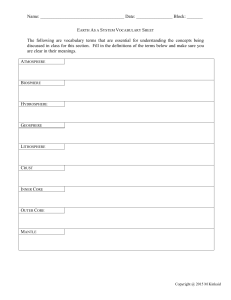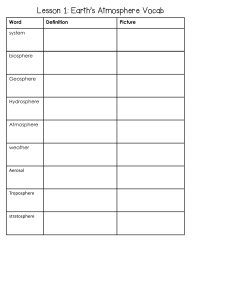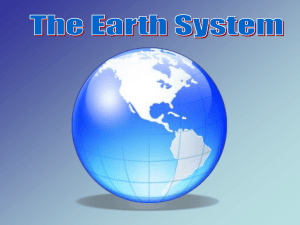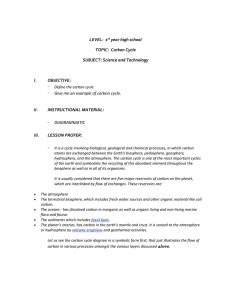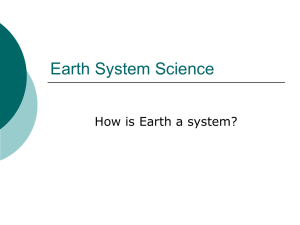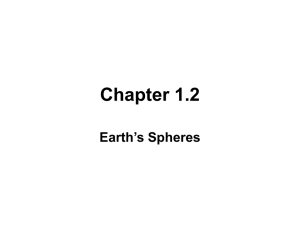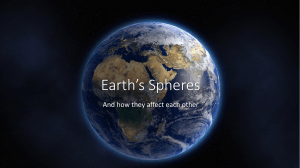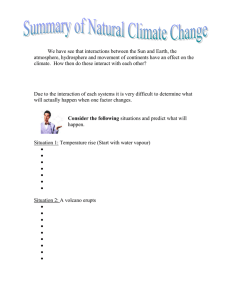Earth Systems & Interactions: Carbon & Phosphorus Cycles
advertisement
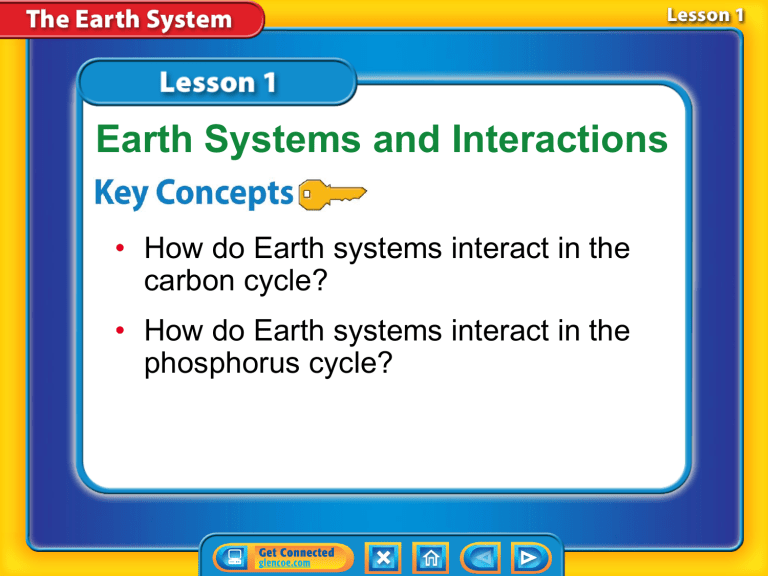
Earth Systems and Interactions • How do Earth systems interact in the carbon cycle? • How do Earth systems interact in the phosphorus cycle? Earth Systems and Interactions • carbon cycle • greenhouse gas • phosphorus cycle Earth Systems Earth has smaller systems that function together and make the larger Earth system: • the atmosphere • the hydrosphere • the geosphere • the biosphere Earth Systems (cont.) • Matter and energy are transported among all Earth systems. • The outermost Earth system is a mixture of gases and particles of matter called the atmosphere. • It forms a layer around the other Earth systems. Earth Systems (cont.) • The atmosphere is mainly nitrogen and oxygen gases. • These gases move freely, helping transport matter and energy among Earth systems. Earth Systems • The hydrosphere contains all of Earth’s water. • Most of the water in the hydrosphere is on the Earth’s surface—in oceans, glaciers, lakes, ice sheets, ponds, and rivers. • Water in the hydrosphere continuously moves from place to place. The amount of water on Earth remains constant over time. Earth Systems (cont.) • Many substances are easily dissolved in water, such as salts, minerals, and dissolved gases. • These dissolved substances move with the water and results in the interaction among Earth’s systems. • The hydrosphere interacts with the geosphere through weathering and erosion. • The largest Earth system is the geosphere, which includes the thin layer of soil and rocks on Earth’s surface and all the underlying layers of Earth. • Because the geosphere is mainly solid, materials in this system tend to move slowly. Earth Systems (cont.) • All living things on Earth make up the biosphere. • Because organisms live in air, water, soil, and rocks, the biosphere is within all other Earth systems. • Living things survive using gases from the atmosphere, water from the hydrosphere, and nutrients found in soil and rock Interactions Among Earth Systems • Earth systems interact by exchanging matter and energy. • Matter and energy often change in form as they flow between systems. The water cycle is the continuous movement of water on, above, and below Earth’s surface. •The water cycle goes through the processes of precipitation, evaporation and condensation. •precipitation: any form of water that falls from the clouds and reaches Earth’s surface •evaporation: the process by which water molecules in liquid water escape into the air as water vapor •condensation: the process by which molecules of water vapor in the air become liquid water The rock cycle is the series of processes that change rocks from one form to another. •Some processes take place deep within Earth, while others, such as weathering and erosion, take place on or near Earth’s surface. The carbon cycle is the series of processes that continuously move carbon among Earth systems. Carbon in the form of CO2 leaves the atmosphere and enters the biosphere during photosynthesis. The Mcgraw-Hill Companies Carbon is in reservoirs, or storage places, within all Earth systems. CO2 is a greenhouse gas. Greenhouse gases are gases in the atmosphere that absorb and reradiate thermal energy from the Sun. When levels of atmospheric CO2 increase, Earth’s average temperature increases, this phenomenon is known as global warming. Interactions Among Earth Systems •Some important elements do not cycle through all Earth systems. (cont.) •The phosphorus cycle moves phosphorus among three Earth systems. • Earth systems include the atmosphere, the hydrosphere, the biosphere, and the geosphere. • Examples of interactions among Earth systems include the water cycle, the rock cycle, the carbon cycle, and the phosphorus cycle. • Human activities disturb natural cycles. Where is most of Earth’s carbon stored? A. atmosphere B. biosphere C. geosphere D. hydrosphere Which is a greenhouse gas? A. carbon B. carbon dioxide C. oxygen D. phosphorus What enters the atmosphere from the geosphere as CO2? A. carbon B. hydrogen C. phosphates D. phosphorus Do you agree or disagree? 1. The amount of water on Earth remains constant over time. 2. Hydrogen makes up the hydrosphere. 3. Most carbon on Earth is in the atmosphere.
